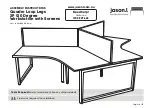
32
3.27 Additive Permissive Fail
Problem:
Used with Authorize permissive feature (software permissive). It is possible once
software permissive (rate selection) is provided, the active Authorize permissive changes to a different
Authorize permissive. Thereby, providing an inconsistency, as to the desired injection rate.
Cause:
The ProPAC-3 software is designed to alarm in the event of an inconsistency between two
or more Authorize rate selections for over 30 seconds. The Authorize permissive must go to zero (0)
permissive state within 30 seconds or the unit will alarm. Note: Alarm will automatically reset after all
Authorize commands are removed for a period of time.
Troubleshooting:
Call Terminal Automation System (TAS) vendor.
3.28 Calibration Alarm
Problem:
Current EPA regulations require the periodic calibration of each additive injector and the
documentation of the date of the last calibration.
Cause:
The ProPAC-3 can provide a quarterly Calibration Alarm by utilizing the on board Real
Time Clock (RTC). The alarm assists the user in assuring regulatory compliance. When the ProPAC-3 is in
this alarmed state, it does not prevent further injection attempts. The alarm is activated when the injector
has not been calibrated for a period of three months.
Troubleshooting:
Calibrate the injector.
3.29 Additive Quantity Alarm
Problem:
Although it is unlikely during most normal operations, it is possible the injector may
under inject or over inject additive during a load without the injector entering any of the previous alarm
states. The following may contribute to this condition:
1.
Additive pre-load feature is used and the product load is terminated soon after the start of the
product load. Under this condition, additive is pre-loaded on the front end of the load to make up for the
additive not injected during product line flushing. If product loading is terminated early in the load, the
additive quantity may be high (depending on program setting for the Quantity Alarm-High).
2.
Excessive product is flushed at the end of a load. This condition may adversely affect the
additive/product ratio by making the additive quantity out of programmed specifications.
3.
Frequency flush is activated early because of changes in product flow rate caused by varying
product line pressure.
Cause:
Depending on user programming, the ProPAC-3 will alarm anytime the additive/product
ratio exceeds either the upper or lower programmed limits, thus providing an on-line continuous product
quality check during product loading. When the ProPAC-3 is in this alarmed state, it does not prevent
further injection attempts.
Troubleshooting:
Many times this alarm will occur in conjunction with one of the other injector
alarms. If so, follow the troubleshooting instructions for that alarm. If not, call Titan for additional
assistance.
Summary of Contents for ProPAC-3
Page 39: ...39 ...
















































